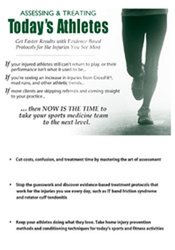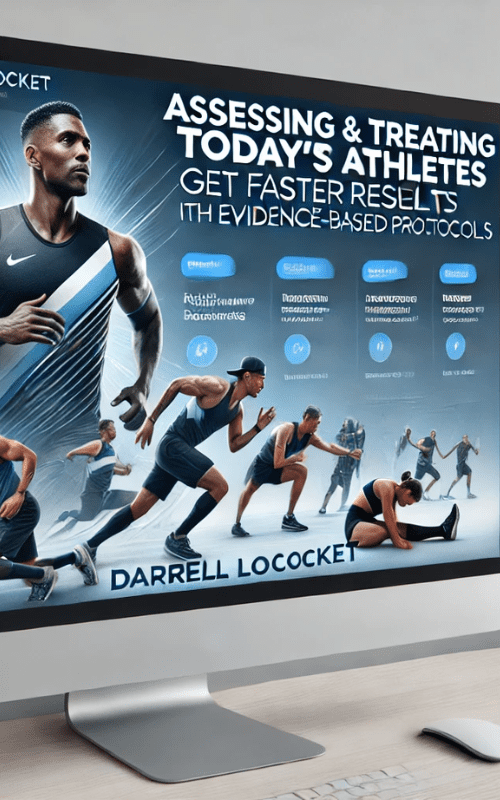Assessing & Treating Today’s Athletes -Get Faster Results with Evidence-based Protocols for the Injuries You See Most – Darrell Locket
Assessing & Treating Today’s Athletes -Get Faster Results with Evidence-based Protocols for the Injuries You See Most – Darrell Locket has the same quality as the author’s salapage.
Overview
Salepage check: Assessing & Treating Today’s Athletes -Get Faster Results with Evidence-based Protocols for the Injuries You See Most
Author: Darrell Locket
- Faculty:
- Darrell Locket
- Duration:
- 6 Hours 11 Minutes
- Format:
- Audio and Video
- Copyright:
- Oct 07, 2013
Description
Why Some Injured Athletes Never Return to Play—and What You Can Do About It
Whether they’re wrecking themselves in CrossFit® or football, record numbers of weekend warriors are cropping up with the sports injuries of professional athletes. That means business is booming for rehab professionals like you. However, with more athletes skipping physicians than ever before, you’ve got to be confident in your assessment skills if you hope to treat symptoms at their source. If your caseload has stalled during this busy time with patients who aren’t making much progress, now’s the time to reevaluate your evaluations.
This hands-on program will take your sports medicine team to the next level, equipping you with evidence-based, multidisciplinary protocols for the athletic injuries you see most. From IT bands to impinged rotator cuffs, this course provides efficient clinical pathways for each member of your team, eliminating the guesswork from assessment, evaluation, treatment, and rehabilitation. With plenty of practice throughout the day, you’ll quickly grasp the “why,” “what,” and “how” of common conditions like acute/chronic inflammation, microtrauma, neuromuscular imbalances, and joint instability. The effective interventions you’ll try out in class will feel like second nature by the time you return to work.
Finally, explore the unique biomechanical demands of common sports and fitness activities and take home injury prevention methods and conditioning techniques that keep your clients doing what they love, whether they’re swinging golf clubs or kettlebells.
Handouts
| Manual – Assessing and Treating Today’s Athletes (115.05 MB) | 39 Pages | Available after Purchase |
Outline
Sports Medicine Team Practitioner Approach to Treatment of Sports Injuries
- Treatment of the injury: Non-operative and operative (types of surgery)
- Healing phases and rehabilitation
- Lab: Comprehensive sports injury physical examination
- Lab: Gait, posture, and functional kinetic chain assessment
LAB: Physical Examination of the Ankle & Lower Leg
- Preventive measures, mechanics of injuries, inspection of gait, range of motion, manual muscle testing, and special stress tests
- Pes anserinus bursitis or tendonitis
- Shin splint or medial tibial stress syndrome
- Posterior tibial tendon dysfunction
- Achilles tear, strain, bursitis, tendonitis, or tenosynovitis
- Gastrocnemius and soleus strain
- Retrocalcaneal bursitis or Sever’s syndrome
- Lateral and medial ankle sprain
- Syndesmotic injuries (high ankle sprain)
- Tarsal tunnel
- Interdigital (Morton’s) neuroma
- Plantar fasciitis
- Peroneal tendon subluxation
- Jones fracture
- Stress fracture
- Avulsion fractures
LAB: Physical Examination of the Knee, Hip, & Thigh
- Preventive measures, inspection of gait, squats, lunges, range of motion, mechanics of injuries, palpation, and special stress tests
- Ligament injuries
- Anterior and posterior cruciate
- Medial and lateral collateral
- Cartilage injuries
- Meniscal tears
- Articular
- Degenerative joint disease
- Ligament injuries
- Patellafemoral injuries
- Chondromalacia
- Malalignment and instability
- Tendonitis or Osgood-Schlatter
- Degenerative joint disease
- Muscle injuries
- Gluteus maximus weakness
- Gluteus medius and minimus weakness
- Tensor fascia lata weakness
- Quadriceps femoris and hamstring strain/tendonitis/ruptures
- Hip injuries
- Hip impingement
- Trochanteric bursitis
- Adductor strain
- Iliotibial band friction syndrome
LAB: Physical Examination of the Shoulder & Arm Injuries
- Preventive measures, inspection posture, functional movement, mechanics of injuries, range of motion, palpation, and special stress tests
- Glenohumeral instability, anterior or posterior joint
- Rotator cuff strain, impingement or tendonitis
- Pectoralis strain
- Acromioclavicular joint sprain
- Brachial plexus (burner/stinger)
- SLAP lesion
- Bicipital tenosynovitis/subluxation
- Triceps and biceps strain
- Bursitis of elbow
- Lateral and medial epicondylitis of the elbow
LAB: Physical Examination of the Back Injuries
- Preventive measures, inspection gait, posture, functional kinetic chain assessment, mechanics of injuries, range of motion, palpation, and special stress tests
- Piriformis syndrome and sciatica
- Erector spinae muscle strain
- Sacroiliac sprain
- Acute and chronic low back pain
- Lumbar spinal stenosis
LAB: Physical Examination of the Wrist, & Hand Anatomy
- Preventive measures, inspection posture, mechanics of injuries, range of motion, palpation, and special stress tests
- Trifibrocartilage (TFC)
- DeQuervain’s
- Hand and fingers fracture/other conditions
- Gamekeeper’s thumb
*This course content is not intended for the use by participants outside their scope of practice regarding their state licenses, national certification, or regulation.
Faculty
Darrell Locket, MAT, ATC/L, LMT, CSCS, NSCA-CPT, GT Provider, is the Owner/Director of ABz-Solute, LLC, Related seminars and products: 3
Darrell Locket, MAT, ATC/L, LMT, CSCS, NSCA-CPT, GT Provider, is the Owner/Director of ABz-Solute, LLC, Jacksonville’s leading provider of rehabilitation, conditioning, health education, and injury prevention for athletes, individuals, industrial workers, and healthcare professionals. Previously, Mr. Locket served as the Strength and Conditioning Coordinator and Head Athletic Trainer for Lincoln University of Pennsylvania, where the Men’s and Women’s Track and Field Teams have combined for 17 NCAA Division III National Championships.
Mr. Locket completed his Bachelor of Science and Master of Arts in Teaching degrees in Physical Education with an emphasis in Sports Medicine from the University of West Alabama. He also attended the Utah College of Massage Therapy to expand his overall knowledge of manual therapy. In addition, Mr. Locket holds certifications and memberships as an Athletic Trainer, Certified from the National Athletic Trainers’ Association; a Certified Strength and Conditioning Specialist and Certified Personal Trainer from the National Strength and Conditioning Association; a Graston Technique® Provider; and a PerformTex™ Kinesiology Taping Provider. Mr. Locket’s unique combination of education, experience, and passion translates into highly innovative and effective rehabilitation solutions.
Speaker Disclosures:
Financial: Darrell Locket is an adjunct instructor at Edward Waters College. He is the owner of ABz-Solute, LLC. Mr. Locket receives a speaking honorarium from PESI, Inc.
Non-financial: Darrell Locket is a member of the National Athletic Trainer’s Association; and the National Strength and Conditioning Association.
Curriculum
FAQs
Requirements
- Professional Background: Participants should have a foundational understanding of sports medicine, physical therapy, athletic training, or related fields.
- Educational Prerequisites: A degree or certification in healthcare, fitness, or rehabilitation is recommended to fully grasp the course material.
- Technical Needs: Reliable internet access and a device capable of streaming video content are necessary for accessing digital course materials.
Features
- Comprehensive Curriculum: Covers anatomy, biomechanics, and pathology of common sports injuries.
- Hands-On Labs: Practical sessions on assessment techniques and rehabilitation strategies.
- Evidence-Based Protocols: Utilizes current research to inform treatment plans.
- Multidisciplinary Approach: Integrates perspectives from various healthcare disciplines for holistic care.
- Injury Prevention Techniques: Focuses on methods to reduce the likelihood of future injuries.
Target audiences
- Physical Therapists and Assistants: Seeking advanced techniques for athlete rehabilitation.
- Athletic Trainers: Aiming to enhance assessment and treatment protocols for sports injuries.
- Sports Medicine Physicians: Interested in evidence-based approaches to common athletic injuries.
- Strength and Conditioning Coaches: Looking to integrate injury prevention strategies into training programs.
- Massage Therapists: Wanting to expand their knowledge in treating sports-related musculoskeletal issues.


